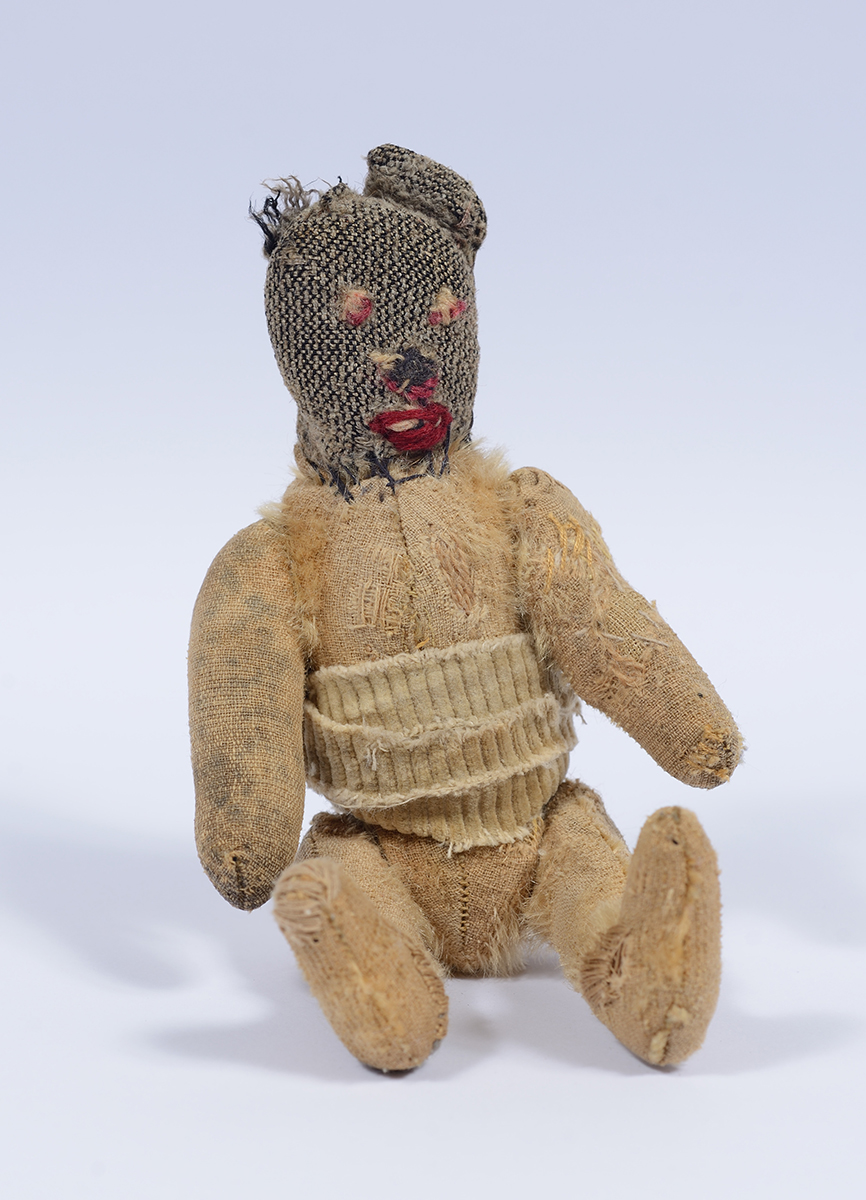This teddy bear belongs to Fred Lessing, a child survivor of the Holocaust who currently resides in the United States. Lessing was a young schoolboy when the war reached Holland. He was hidden by a Christian family during which time the teddy bear became his closest friend, his confidante and source of comfort. After the war ended, the teddy bear remained with Fred Lessing, until he agreed to lend it to Yad Vashem for this exhibition.
Yad Vashem Artifacts Collection
When first approached by Yad Vashem, Lessing asked for a few days to consider the possibility of sending the bear so far away. After careful thought, he called the museum curators with this response:
"I spoke with my bear and I explained to him that, for the first time ever we would have to part. The reason was that he had to carry out an important task-he had to travel to Israel to take part in an exhibition with other toys from the period of the Holocaust and there he would tell our story to the children who came to visit the exhibition."
The Mona Lisa of Yad Vashem
During my research for the exhibition “No Child’s Play”, I met with Ann Shore, the president of the Hidden Child Foundation, who was most enthusiastic about the exhibition and promised to help find artifacts for it.
During our discussions about various ideas for the exhibition, Ann told me the story of Fred Lessing and his teddy bear. Lessing, a child survivor of the Holocaust, is a psychologist who lives in the U.S. In 1987, he came across a photograph of Dutch children wearing the yellow star. A jacket worn by one of the boys in the photograph helped Lessing identify himself as one of the schoolchildren. Looking at the picture brought back many memories of the war years. Lessing remembered his family being separated and going into hiding. He also remembered that his most beloved possession - his teddy bear – had its head bitten off by a dog. Lessing’s mother had sewn a new head for the bear from the jacket worn by Lessing in the photograph.
After receiving a new head of brown fabric and a face embroidered by Lessing’s mother, the teddy bear took on a different, almost human, look.
Ann told me that it was highly unlikely that Yad Vashem would be able to obtain the teddy bear for the exhibition, as Lessing never parted from it.
It was the sole surviving object from his childhood – a childhood spent in the shadow of fear.
Still, I decided to try my luck, and called Lessing directly. Although he was extremely cooperative and wanted to help us with the exhibition, he was also understandably reluctant to send us his cherished bear. He assured us that he would give the matter further thought, and we waited for his answer, hoping he would agree.
A few days later, we spoke again. Lessing’s answer to my request, and the words he said, bring tears to my eyes whenever I recall them. He said, “I spoke with my bear and I explained to him that, for the first time ever, we would have to part. The reason was that he had to carry out an important task – he had to travel to Israel to take part in an exhibition with other toys from the period of the Holocaust and there he would tell our story to the children who came to visit the exhibition.” It seemed to me that it was not only I who cried as I heard these words across the ocean.
I called an international shipping company that specializes in transporting museum artifacts and asked them to ship Lessing’s bear to Jerusalem. After taking down a few details, the shippers asked me to assess the value of the item for insurance purposes. I answered with a question: “Do you know the Mona Lisa?” They replied, “yes!” So I explained: “Well, the bear is worth more than the Mona Lisa because it is the lifeline of its owner.” There was silence on the line.
After a while, the day came when the bear was due to arrive. Haviva Peled-Carmeli, head of Yad Vashem’s Artifacts Retrieval Department, and I decided to wait together for the delivery. In the early afternoon, a large car drew up to the museum. The shipping representative and the courier who had accompanied the bear from the U.S. carried the carton to the artifacts department, were we requested that they open it for us. The car’s driver, anxious to leave, became more and more annoyed, but the shipping representative proceeded to open the carton. The procedure took time, as meters of protective wrapping had to be unraveled before revealing a small box. With great emotion we opened it and found ourselves face to face with what resembled a tiny human fetus. The little stuffed toy had lost all its yellow fur and had taken on the appearance of a tiny human being. Haviva and I burst into tears as we held the bear in our arms. Suddenly the driver exclaimed, “what on earth is going on? First we deliver a large carton containing what looks like a bundle of rags, and then you burst out crying!” Overcome by curiosity, and forgetting that he was in a hurry to leave, he sat down on the carpet, and waited for an explanation. As we recounted Fred Lessing’s story, the driver had tears in his eyes.
From that time on, Lessing’s bear has been called the “Mona Lisa.” It is on display in our exhibition and the expression on its face seems to say, “don’t leave me.” Next to the bear are displayed two photographs of Lessing as a five-year-old Dutch boy, with a sweet, mischievous face, and dark curls.
Rarely do visitors pass Lessing’s bear without stopping. Sometimes as I prepare to leave the office in the evening, I am sad at the thought of leaving the teddy bear alone in its glass case. But the next day, I am always happy to find him again. The little bear tells its story to everyone who comes to see it – children, youth, and adults.
Whenever I take visitors around the exhibition I always recount the story of Lessing and his bear. Many dignitaries visit the exhibition, and I always ask if I can photograph them next to Lessing’s bear so I can send the photographs with my greetings to Lessing. Every major world leader has been photographed next to the little bear and it seems to me that it is they who feel honored. Presidents, prime ministers, tough army generals – all change their expressions when they stop at the little glass case from which Lessing’s bear stares with sad, accusing eyes.
Due to the exhibition’s success, and particularly because of the many educational projects for young people that have been organized around it, Yad Vashem decided to turn “No Child’s Play” into a permanent exhibition. The time came, therefore, for me to once again approach Fred Lessing with a difficult request. I asked him if he would be prepared to extend the loan of his bear. Then, with great trepidation, I ventured to ask whether he would consider donating his bear to Yad Vashem on a permanent basis. Some time later, I received a letter from Lessing in which he thanked me for the photographs and greetings I had sent him. At the end of the letter he explained how hard it was for him to part with his bear, even though it was now over two years since they had separated. Then he asked, “... and if, ultimately, I agree to give him to you on a permanent basis, where will he live?”
I doubt there is a museum curator anywhere in the world who has had to answer such a difficult question. And the truth is, I do not know the answer.




